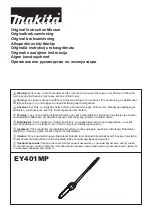
31
USING THE MITER GAUGE
For your own safety, always
observe the following safe-
ty precautions in addition to the safety in-
structions on Pages 2, 3, 4, 5 and 6.
CROSSCUTTING, MITER CUTTING, BEVEL
CUTTING, COMPOUND MITER CUTTING and
when RABBETING across the end of a narrow
work piece, the MITER GAUGE is used.
Never make these cuts freehand (without using
the miter gauge or other auxiliary devices) be-
cause the blade could bind in the cut and cause
a KICKBACK or cause your fingers or hand to slip
into the blade.
Always lock the miter gauge securely when in
use.
Remove rip fence from table during any opera-
tions which utilize the miter gauge.
The miter includes a “T” groove disk
7 for easy
insertion into table groove and quicker removal
from the table (Fig. 50).
When cross cutting and the blade set at 90° or
45° to the table, the miter gauge can be used in
either slot on the table. When cross cutting and
the blade is tilted, use slot on right side of table
where the blade is tilted away from your hands
and miter gauge.
TO ADJUST THE MITER ANGLE:
Loosen lock knob
1 and set the miter gauge body
2 so the pointer 3 is at desired angle, then tighten
lock knob
1 (Fig. 50). The miter gauge body 2 will
stop at 90° and both right and left 45°. To rotate
the miter gauge body
2 beyond these points, the
stop plate
4 must be flipped out of the way.
MITER GAUGE AUXILIARY FACING
A template for drilling holes in the miter gauge is
provided on page 48, which allows you to attach
an AUXILIARY FACING
5 to provide additional
support to cut longer pieces. Select a suitable
piece of smooth straight wood, drill two holes
through it and attach it with screws
6 (Fig. 51).
Example:
A. Drill 1/4” dia. holes through miter gauge.
B. Drill 5/32” dia. holes through (board 3/4” thick,
3” high, and desired length).
C.
Attach with two No. 12 round head wood
screws 1-1/2” long,
6, not included (Fig. 51).
Be sure screws never protrude above outside
surface of facing.
Be sure facing does not interfere with the proper
operation of the saw blade guard.
NOTE: When bevel crosscutting, attach facing so
that it extends to the right of the miter gauge and
use the miter gauge in the groove to the right of
the blade.
CROSSCUTTING
CROSSCUTTING is known as cutting wood
across the grain, at 90°, or square with both the
edge and the flat side of the wood. This is done
with the miter gauge set at 90° (Fig. 52).
Make sure blade guard is installed for all “through-
Fig. 50
2
1
7
8
3
4
Fig. 51
6
5
1600A009XC 09-15.indb 31
9/14/15 1:51 PM
















































